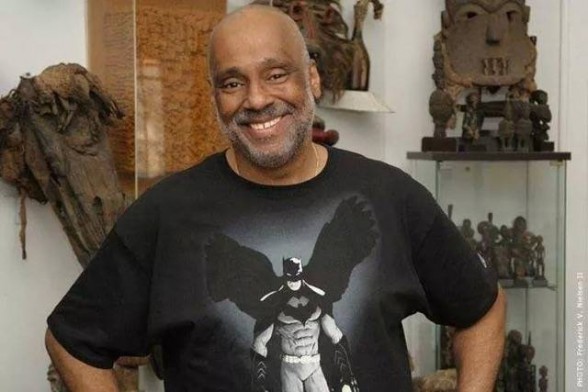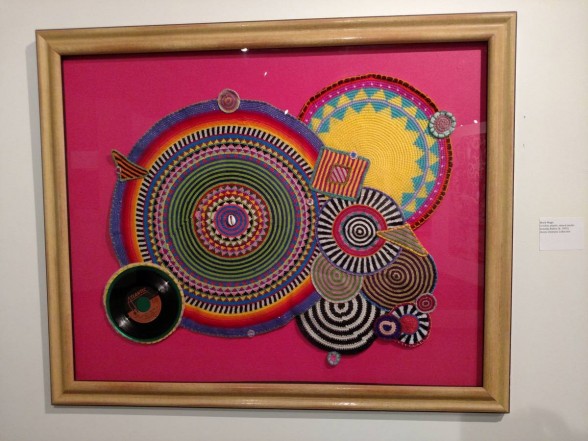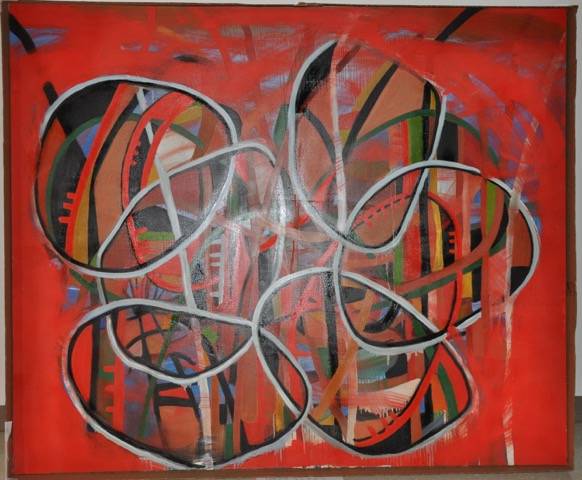[Jennifer gets a chance to interview artist and collector Danny Simmons, uncovering the influences that stretch from his collected works into his original art. Simmons is planning a move to the Philadelphia area. — the Artblog editors]
Two works hang side-by-side. One is a fabric collage and one is a color photograph. The collage is by the artist, Danny Simmons, and the photo is by another artist, Mickalene Thomas. The two works look great together. Why does this matter? Because Mickalene Thomas’ photo is in Danny Simmons’ art collection, and Simmons’ fabric collage has uncanny concordance with the photo, which raises the delicate, delicious, tricky issue of a collector/artist being inspired by his collection.
Mixed-media mingling

Simmons’ canvas has a surface of patterned fabrics organized into abstract, rhythmic arrangements. Thomas’s photograph features an odalisque-like subject resting on a sofa in a room all-adorned to an extraordinary degree in bright fabrics from the 1970s. Both emphasize sensual, lush surfaces, and revel in pattern, color, and abstract design.
These types of pairings abound in Badass Art Man: Danny Simmons at the African American Museum in Philadelphia, on view through May 31. This mingling is an organizing principle of this show, and curated passages like the one described above successfully suggest deep conversations between Simmons’ work and that of his collection. There are other strong pairings here, including the placement of Simmons’ paintings next to a work by Johnny Warangkula Tjupurrula, which has an all-over surface of white spirals and arrows and white and black dots.

I had the opportunity to ask Simmons about his artistic inspirations when we spoke in a phone interview. He acknowledged that what he looks at and collects generally are, “all inspiration for what goes on the canvas”. In this exhibition, it becomes clear that Simmons shares some of the vocabulary used by the artists he admires, but there is also a decidedly personal language in his paintings.
“Untitled” (2013) exemplifies his personal, layered, energetic, abstract style, and perhaps a few citations from artists who inspire him. In the painting, there are connected round shapes, like chain links, interwoven with or on top of a transparent white haze; dots, directional lines, and small abstract pictograms appear throughout. These dots and arrows may be reminiscent of Tjupurrula’s untitled acrylic painting. The repeating geometric shapes and connections may share similarities with Mbuti bark paintings, which are both artistic and spiritual touchpoints for Simmons, as he described to me. He noted that his collection contains several bark paintings, which are also sometimes known as Mbuti Pygmy Bark-Cloth and typically hail from the Congo. Philadelphia’s own Indigo Arts Gallery at the Crane Art building has several examples on its website.
Speaking to Simmons about his collection and work was thrilling. He described the tribal bark paintings as map-like, with “line work so abstract”. He said he “bought four of them on a buying spree”. Simmons noted that the artists he looks to for inspiration include the Mbuti people and artists such as Wilfredo Lam and Cy Twombly. His passion in describing his collecting and his spiritual connections to the artists he admires is stirring.
Art, service, and social justice

Simmons’ art collection is wonderfully inclusive and diverse. Works by art stars–Kara Walker, Jean-Michel Basquiat–are exhibited here next to items from vernacular and pop culture–the first Black comic book, and other All Negro Comics, for example. Simmons also collects historic action figures, and he lamented with great humor his disappointment that they were not included in the exhibition. The comic books, pop culture items, and works by artists not often seen in big group exhibitions, such as James Van Der Zee and Xenobia Bailey, are standouts here.
Ultimately, it is a variety of items and presentation methods in Badass Art Man that allows us to get to know Danny Simmons deeply. We learn about him through his own artwork and his collection, and through the conversations between the two; there are several video interview segments included throughout the galleries. This exhibition creates a portrait of Simmons as a keen observer of art, art-world politics, and social issues. He speaks candidly in the interviews about his own recovery from addiction, and the personal importance of service to others. Simmons told me that while finding his path to recovery, art was a centering and supporting force; it was “wrapped into having something to keep”. Service to others was “an outlet…and gave me a new life.”

All together then, Badass Art Man shifts from being just an art exhibition to something more like a showcase or an investigation of a man, his work, and his passions. These passions drive his art and collecting, and his dedication to philanthropy and support of underserved and underrepresented communities.
But despite the many gems in Badass Art Man, there are challenges in this exhibition, particularly in the presentation of the artwork. A few pieces are hung in darkness, or under non-working lights or bulbs. There is a randomness to the labeling of objects; some works are left frustratingly unidentified and unlabeled, or with only partial information. To be frank, this isn’t my first experience with these challenges at this institution.
Prior to his art career, Simmons was a practicing social worker. He grew up with two artistic parents and an active awareness of the civil rights movement. He was a junior member of the Black Panther Party, and, as he describes in one of the videos, his social awareness was a way of “connecting beyond the self”. When we spoke, he described how in the late 1980s, he noticed the lack of representation of artists of color and women artists in the galleries of New York City and mobilized his social, activist, and artistic awareness to remedy this. His strategy included opening galleries–Sanctuary Gallery, Corridor Gallery–and founding Def Poetry Jam to support a variety of voices in spoken word and performance.
Simmons also co-founded the Rush Philanthropic Arts Foundation, which continues its already successful 20-year run of supporting and fostering art education, youth programs, and exhibition opportunities. Local news reports suggest that Simmons will be bringing the Rush Foundation to Philadelphia, a thrilling thought for anyone following arts funding in this city, and his publicist confirms that he is scoping out real estate for an intended move to Philadelphia within the next month.
Badass Art Man: Danny Simmons is on view at the African American Museum in Philadelphia through May 31, 2015.









